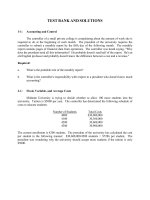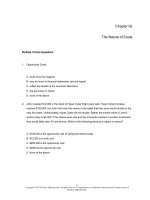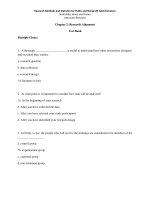Ch02 marketing research process and systems for decision making SMM
Bạn đang xem bản rút gọn của tài liệu. Xem và tải ngay bản đầy đủ của tài liệu tại đây (90.11 KB, 8 trang )
Chapter 02 - Marketing Research: Process and Systems for Decision Making
Chapter 2
Marketing Research: Process and Systems
for Decision Making
High-Level Chapter Outline
I. The Role of Marketing Research
II. The Marketing Research Process
A. Purpose of the Research
B. Plan of the Research
Primary versus Secondary Data
Qualitative versus Quantitative Research
Company versus Contract Research
C. Performance of the Research
D. Processing of Research Data
E. Preparation of the Research Report
F. Limitations of the Research Process
III. Marketing Information Systems
Detailed Chapter Outline
I. The Role of Marketing Research
Marketing research is the process by which information about the environment is
generated, analyzed, and interpreted for use in marketing decision making.
Marketing research does not make decisions, but it can substantially increase the chances
that good decisions are made.
Marketing managers should recognize that:
o Even the most carefully executed research can be fraught with errors
o Marketing research does not forecast with certainty what will happen in the future
o They should make decisions in light of their own knowledge and experience, since
no marketing research study includes all of the factors that could influence the
success of a strategy
Although marketing research does not make decisions, it can reduce the risk associated
with managing marketing strategies.
2-1
Copyright © 2014 McGraw-Hill Education. All rights reserved. No reproduction or distribution without the
prior written consent of McGraw-Hill Education.
Chapter 02 - Marketing Research: Process and Systems for Decision Making
It is vital for investigating the effects of various marketing strategies after they have been
implemented.
Today, many marketing researchers work hand-in-hand with marketing managers
throughout the research process and have responsibility for making strategic
recommendations based on the research.
II. The Marketing Research Process
Marketing research can be viewed as the systematic process for obtaining information to
aid in decision-making.
There are many types of marketing research.
The five Ps of the research process are (Figure 2.1):
o Purpose of the research
o Plan of the research
o Performance of the research
o Processing of research data
o Preparation of research report
A. Purpose of the Research
The first step in the research process is to determine explicitly why the research is
needed and what it is to accomplish.
Quite often a situation or problem is recognized as needing research, yet the nature of
the problem is not clear or well defined nor is the appropriate type of research evident.
Managers and researchers need to discuss and clarify the current situation and develop
a clear understanding of the problem.
Managers and researchers should agree on:
o The current situation involving the problem to be researched
o The nature of the problem
o The specific question or questions the research is designed to investigate
This step is crucial since it influences the type of research to be conducted and the
research design.
B. Plan of the Research
A research plan spells out the nature of the research to be conducted and includes an
explanation of such things as the sample design, measures, and analysis techniques to
be used.
Three critical issues influence the research plan are:
o Whether primary or secondary data are needed
2-2
Copyright © 2014 McGraw-Hill Education. All rights reserved. No reproduction or distribution without the
prior written consent of McGraw-Hill Education.
Chapter 02 - Marketing Research: Process and Systems for Decision Making
o
o
Whether qualitative or quantitative research is needed
Whether the company will do its own research or contract with a marketing
research specialist
Primary versus Secondary Data
Primary data are the data collected specifically for the research problem under
investigation.
Secondary data are the data that have previously been collected for other purposes
but can be used for the problem at hand.
Secondary information has the advantage of usually being cheaper than primary
data, although it is not always available for strategy- specific research questions.
There are many types of secondary data that could be useful for understanding a
market and for answering a particular research question.
Some of these data can be found from sources internal to the organization such as
sales invoices, quarterly sales reports, and marketing research done by the
organization.
Other secondary data must be obtained from sources external to the organization
and include information such as syndicated data providers and by the government,
such as U.S. census data.
Figure 2.2 lists the common types of information that is available in a secondary
data research.
Qualitative versus Quantitative Research
Qualitative research typically involves face-to-face interviews with respondents
designed to develop a better understanding of what they think and feel concerning
a research topic.
The two most common types of qualitative research are focus group and long
interviews.
o Focus groups typically involve discussions among a small number of
consumers led by an interviewer and are designed to generate insights and
ideas about products and brands.
o Long interviews are conducted by an interviewer with a single respondent
for several hours.
Quantitative research involves more systematic procedures designed to obtain and
analyze numerical data.
There are four common types of quantitative research in marketing are
observation, surveys, experiments, and mathematical modeling.
o Observational research involves watching people and recording relevant
2-3
Copyright © 2014 McGraw-Hill Education. All rights reserved. No reproduction or distribution without the
prior written consent of McGraw-Hill Education.
Chapter 02 - Marketing Research: Process and Systems for Decision Making
o
o
o
facts and behaviors.
Survey research involves the collection of data by means of a questionnaire
either by mail, phone, online or in person.
Experimental research involves manipulating one variable and examining
its impact on other variables.
Mathematical modeling research often involves secondary data. It is useful
because it provides an efficient way to study problems with extremely large
secondary data sets.
Company versus Contract Research
Most large consumer goods companies have marketing research departments that
can perform a variety of types of research.
In addition many marketing research firms, advertising agencies, and consulting
companies do marketing research on a contract basis.
C. Performance of the Research
Performance of the research involves preparing for data collection and actually
collecting them.
In terms of actual data collection, a cardinal rule is to obtain and record the maximal
amount of useful information, subject to the constraints of time, money, and
respondent privacy.
Failure to obtain and record data clearly can obviously lead to a poor research study,
while failure to consider the rights of respondents raises both practical and ethical
problems.
Thus, both the objectives and constraints of data collection must be closely monitored.
D. Processing of Research Data
Processing research data includes the preparation of data for analysis and the actual
analysis of them.
The appropriate analysis techniques for collected data depend on the nature of the
research questions and the design of the research.
Qualitative research data consist of interview records that are content analyzed for
ideas or themes.
Quantitative research data may be analyzed in a variety of ways depending on the
objectives of the research.
A critical part of this stage is interpreting and assessing the research results.
Marketing researchers should always double-check their analysis and avoid
2-4
Copyright © 2014 McGraw-Hill Education. All rights reserved. No reproduction or distribution without the
prior written consent of McGraw-Hill Education.
Chapter 02 - Marketing Research: Process and Systems for Decision Making
overstating the strength of their findings.
E. Preparation of the Research Report
The research report is a complete statement of everything in a research project and
includes a write-up of each of the previous stages as well as the strategic
recommendations from the research.
Figure 2.4 lists the types of questions marketing researchers and managers should
discuss prior to submitting the final research report.
Research reports should be clear and unambiguous with respect to what was done and
what recommendations are made.
Researchers should work closely with managers to ensure that the study and its
limitations are fully understood.
F. Limitations of the Research Process
Many problems and difficulties must be overcome if a research study is to provide
valuable information for decision making.
The major goal of most test marketing is to measure new product sales on a limited
basis where competitive retaliation and other factors are allowed to operate freely.
Problems that could invalidate test marketing study results are listed below.
o Test market areas are not representatives of the market in general in terms of
population, characteristics, competition, and distribution outlets.
o Sample size and design are incorrectly formulated because of budget constraints.
o Pretest measurements of competitive brand sales are not made or are inaccurate,
limiting the meaningfulness of market share estimates.
o Test scores do not give complete support to the study, such that certain package
sizes may not be carried or prices may not be held constant during the test
period.
o Test-market products are advertised or promoted beyond a profitable level for
the market in general.
o The effects of factors influence sales, such as the sales force, season, weather
conditions, competitive retaliation, shelf space, and so forth, are ignored in the
research.
o The test-market period is too short to determine whether the product will be
repurchased by customers.
Careful research planning, coordination, implementation, and control can help reduce
such problems and increase the value of research for decision making.
III. Marketing Information Systems
2-5
Copyright © 2014 McGraw-Hill Education. All rights reserved. No reproduction or distribution without the
prior written consent of McGraw-Hill Education.
Chapter 02 - Marketing Research: Process and Systems for Decision Making
Most marketers use computer-based systems to help them gather, sort, store, and distribute
information for marketing decisions.
A popular form of marketing information system is the marketing decision support system,
which is a coordinated collection of data, tools, and techniques involving both computer
hardware and software by which marketers gather and interpret relevant information for
decision making.
These systems require three types of software:
o Database management software for sorting and retrieving data from external and
internal sources.
o Model base management software for manipulating data in ways that are useful for
marketing decision making.
o A dialog system that permits marketers to explore data base and use models to
produce information to address their decision-making needs.
Marketing decision support systems are designed to handle information from both internal
and external sources.
External information is gathered from outside the organization and concerns changes in the
environment that could influence marketing strategies.
KEY TERMS
Experimental research: Experimental research involves manipulating one variable and
examining its impact on other variables.
Focus groups: A type of qualitative research that typically involves discussions among a small
number of consumers led by an interviewer and designed to generate insights and ideas about
products and brands.
Long interviews: A type of qualitative research conducted by an interviewer with a single
respondent for several hours and designed to find out such things as the meanings various
products and brands have for the person or how a product influences the person's life.
Marketing research: Marketing research is the process by which information about the
environment is generated, analyzed, and interpreted for use in marketing decision making. Most
often consumers or organizational buyers are the subject of the research.
Mathematical modeling: Mathematical modeling involves developing equations to model
relationships among variables to investigate the impact of various strategies and tactics on sales
and brand choices.
2-6
Copyright © 2014 McGraw-Hill Education. All rights reserved. No reproduction or distribution without the
prior written consent of McGraw-Hill Education.
Chapter 02 - Marketing Research: Process and Systems for Decision Making
Observational research: Observational research involves watching people and recording
relevant facts and behaviors.
Primary data: Primary data are data collected specifically for the research problem under
investigation.
Qualitative research: Qualitative research typically involves face-to-face interviews with
respondents designed to develop a better understanding of what they think and feel concerning a
research topic, such as a brand name, a product, a package, or an advertisement.
Quantitative research: Quantitative research involves more systematic procedures designed to
obtain and analyze numerical data.
Secondary data: Secondary data are those that have previously been collected for other
purposes but can be used for the problem at hand.
Survey research: Survey research involves the collection of data by means of a questionnaire
either by mail, phone, or in person.
Test marketing: The major goal of most test marketing is to measure new product sales on a
limited basis where competitive retaliation and other factors are allowed to operate freely. In this
way, future sales potential can often be estimated reasonably well.
ADDITIONAL RESOURCES
Burns, Alvin C. and Ronald Bush. Marketing Research, 7th ed. Upper Saddle River, NJ:
Prentice-Hall, 2014.
Churchill, Gilbert A., Jr.; Tom J. Brown; and Tracy A. Suter. Basic Marketing Research. 8th ed.
Mason, OH: Thomson South-Western, 2014.
Hair, Joseph F., Jr., Robert P. Bush, and David J. Ortinau. Marketing Research. 4th ed. Burr
Ridge, IL: McGraw Hill/Irwin, 2009.
Iacobucci Dawn, and Gilbert A. Churchill, Jr. Marketing Research: Methodological
Foundations. 10th ed. Mason, OH: Thomson South-Western, 2010.
Molhatra, Naresh K. Marketing Research. 6th ed. Upper Saddle River, NJ: Pearson Education,
2010.
2-7
Copyright © 2014 McGraw-Hill Education. All rights reserved. No reproduction or distribution without the
prior written consent of McGraw-Hill Education.
Chapter 02 - Marketing Research: Process and Systems for Decision Making
Zikmund William G., and Barry J. Babin. Essentials of Marketing Research. 5th ed. Mason, OH:
Thomson South-Western, 2013.
2-8
Copyright © 2014 McGraw-Hill Education. All rights reserved. No reproduction or distribution without the
prior written consent of McGraw-Hill Education.









